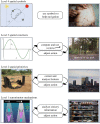Unpacking the navigation toolbox: insights from comparative cognition
- PMID: 38320615
- PMCID: PMC10846957
- DOI: 10.1098/rspb.2023.1304
Unpacking the navigation toolbox: insights from comparative cognition
Abstract
The study of navigation is informed by ethological data from many species, laboratory investigation at behavioural and neurobiological levels, and computational modelling. However, the data are often species-specific, making it challenging to develop general models of how biology supports behaviour. Wiener et al. outlined a framework for organizing the results across taxa, called the 'navigation toolbox' (Wiener et al. In Animal thinking: contemporary issues in comparative cognition (eds R Menzel, J Fischer), pp. 51-76). This framework proposes that spatial cognition is a hierarchical process in which sensory inputs at the lowest level are successively combined into ever-more complex representations, culminating in a metric or quasi-metric internal model of the world (cognitive map). Some animals, notably humans, also use symbolic representations to produce an external representation, such as a verbal description, signpost or map that allows communication of spatial information or instructions between individuals. Recently, new discoveries have extended our understanding of how spatial representations are constructed, highlighting that the hierarchical relationships are bidirectional, with higher levels feeding back to influence lower levels. In the light of these new developments, we revisit the navigation toolbox, elaborate it and incorporate new findings. The toolbox provides a common framework within which the results from different taxa can be described and compared, yielding a more detailed, mechanistic and generalized understanding of navigation.
Keywords: cognitive map; navigation; route; spatial cognition; vector; wayfinding.
Conflict of interest statement
We declare we have no competing interests.
Figures






Similar articles
-
Cognitive maps in the wild: revealing the use of metric information in black howler monkey route navigation.J Exp Biol. 2021 Aug 1;224(15):jeb242430. doi: 10.1242/jeb.242430. Epub 2021 Aug 12. J Exp Biol. 2021. PMID: 34384101 Free PMC article.
-
Navigating cognition: Spatial codes for human thinking.Science. 2018 Nov 9;362(6415):eaat6766. doi: 10.1126/science.aat6766. Science. 2018. PMID: 30409861 Review.
-
Multimodal cognitive interface for robot navigation.Cogn Process. 2011 Feb;12(1):53-65. doi: 10.1007/s10339-010-0386-4. Epub 2011 Jan 4. Cogn Process. 2011. PMID: 21203798
-
Spatial thinking, cognitive mapping, and spatial awareness.Cogn Process. 2021 Sep;22(Suppl 1):89-96. doi: 10.1007/s10339-021-01046-1. Epub 2021 Jul 27. Cogn Process. 2021. PMID: 34313882
-
Non-Euclidean navigation.J Exp Biol. 2019 Feb 6;222(Pt Suppl 1):jeb187971. doi: 10.1242/jeb.187971. J Exp Biol. 2019. PMID: 30728233 Review.
Cited by
-
Differential response by tandem leaders and followers to landmark-rich and landmark-poor environments.Anim Cogn. 2025 May 19;28(1):40. doi: 10.1007/s10071-025-01958-x. Anim Cogn. 2025. PMID: 40388021 Free PMC article.
-
Inter-turn intervals in Paramecium caudatum display an exponential distribution.Commun Integr Biol. 2024 May 31;17(1):2360961. doi: 10.1080/19420889.2024.2360961. eCollection 2024. Commun Integr Biol. 2024. PMID: 38831849 Free PMC article.
-
Landmark knowledge overrides optic flow in honeybee waggle dance distance estimation.J Exp Biol. 2024 Nov 1;227(21):jeb248162. doi: 10.1242/jeb.248162. Epub 2024 Oct 23. J Exp Biol. 2024. PMID: 39319438 Free PMC article.
References
-
- Gladwin T. 2009. East is a big bird: navigation and logic on Puluwat Atoll. Cambridge, MA: Harvard University Press.
-
- Wiener J, et al. 2011. Animal navigation: a synthesis. In Animal thinking: contemporary issues in comparative cognition (eds R Menzel, J Fischer), pp. 51–76. Cambridge, MA: MIT Press. (10.7551/mitpress/9780262016636.003.0005) - DOI
Publication types
MeSH terms
LinkOut - more resources
Full Text Sources
Miscellaneous

